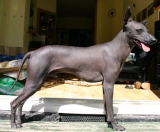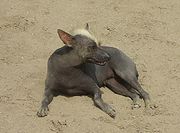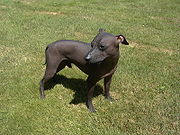
Peruvian Hairless Dog
Encyclopedia
The Peruvian Hairless Dog is a breed
of dog
with its origins in Peruvian pre-Inca cultures. It is one of several breeds of hairless dog
. It is not to be confused with the Xoloitzcuintli
.
ing.
The color of skin can be chocolate-brown, elephant grey, copper, or mottled. They can be totally one color or one color with tongue pink spots. Albinism
is not allowed. The eye color is linked to the skin color. It is always brown, but dogs with light colors can have clearer eyes than darker-skinned dogs.
Peruvian Hairless Dogs vary in size :
Weight is also varied according to size :
The dogs should be slim and elegant, with the impression of force and harmony, without being coarse.
The ears should be candle-flame shaped and erect with the possibility to lay flat.
Proportions of height (at withers
) to length (withers to base of tail) are 1:1.
They are agile and fast. These dogs do not like to be alone, but when trained, can do well. These dogs are intolerant of extreme temperatures. They generally require an owner that understands dog language and are not recommended for beginners.
 The lack of hair leads to a reputation for being clean, for being easy to wash with a sponge, and for a natural lack of flea
The lack of hair leads to a reputation for being clean, for being easy to wash with a sponge, and for a natural lack of flea
s or other parasites. Despite this, the dog needs care, but in another way. The skin should be washed from time to time to remove dirt and prevent clogging of pores. Baby cleaners are a good choice provided that they do not contain lanolin. Some dogs are prone to have acne
or at least blackhead
s. The skin sometimes becomes too dry and can then be treated with moisturizing cream. Again, baby lotion without lanolin is a good product choice to soften and moisturize cleansed skin.
Protection against sunlight is recommended on lightly colored/white dogs. Sun-block or other methods are beneficial to prevent sunburn
.
Protection against cold is necessary when the dog is not able to move around at its own speed under adverse weather conditions. Sensitivity to cold may vary from dog to dog. Smaller dogs seem to be more sensitive to the cold than their larger counterparts.
The rims of the ears sometimes need special attention as they can become dry and cracked.
 The genes that cause hairlessness also result in the breed often having fewer teeth than other breeds, mostly lacking molars and premolars. Some are born with more dentition than others.
The genes that cause hairlessness also result in the breed often having fewer teeth than other breeds, mostly lacking molars and premolars. Some are born with more dentition than others.
One theory is that the hairlessness trait is recessive-lethal, which means that homozygotic hairlessness doesn't exist. This results in an average birthrate of 2:1, hairless : coated.
According to Hans Räber "Enzyklopädie der Rassehunde" T.I 25% of the population is born coated.
While they are recognized by the American Kennel Club
(AKC) for its Foundation Stock Service as Peruvian Orchid dogs, they cannot be shown at AKC shows, they are also registerable with FCI, UKC, NKC,APRI, ACR. Some breeders think that interbreeding with coated (Peruvian) dogs is required to maintain functional teeth and nervous system health in subsequent generations. They say that breeding of hairless with hairless (and common but unacknowledged culling of hairy pups from litters to maintain a "pure" image) leads to short-lived dogs with serious health problems.
However, other breeders (especially in Peru) think the opposite, and are doing well (for centuries already), too.
Like all breeds there are some health problems. These include IBD, seizures, stroke, and skin lesions.
They are very sensitive to toxins and care should be taken in use of insecticides. Insecticides are absorbed through the skin, and body fat keeps these toxins from entering the liver too quickly. Since these dogs have very low body fat, toxins are absorbed too quickly and cause severe damage to the nervous system and GI tract.
they were also kept as pets in pre-Inca cultures from the Peruvian coastal zone. Ceramic hairless dogs from the Chimú, Moche
, and Vicus
culture are well known. Depictions of Peruvian hairless dogs appear around 750 A.D. on Moche
ceramic vessels and continue in later Andean ceramic traditions.
The main area of the Inca Empire (the mountains) is too cold for the natural existence of the dogs.
The Spanish conquest of Peru nearly caused the extinction of the breed. The dogs survived in rural areas, where the people believed that they held a mystical value.
In recent years, the Fédération Cynologique Internationale
(FCI) accepted the breed and adopted an official breed standard
. Before that time, in the United States, some enthusiasts created another type of Peruvian hairless dog, the Peruvian Inca Orchid. The Peruvian Inca Orchid is recognized by the AKC. The club UKC also recognized the breed in recent years.
Also, if provided with a blanket, they will make it their own and carry it from one ambient to other if they move around (without any type of training).
They keep their tongue inside their mouth and do not drool, and as expected, don't shed any hair.
Therefore, it is a very clean dog.
The body temperature of hairless dogs feels higher than other dogs due to the lack of hair.
According to Peruvian folklore, letting the dog "hug" you is believed to help with stomach pain and other disorders such as asthma.
Other myths claim that the dog is a vegetarian or that it cannot bark (actually it does bark very loud).
It is very likely that some of these myths have helped the breed to survive for so long in Peru.
Dog breed
Dog breeds are groups of closely related and visibly similar domestic dogs, which are all of the subspecies Canis lupus familiaris, having characteristic traits that are selected and maintained by humans, bred from a known foundation stock....
of dog
Dog
The domestic dog is a domesticated form of the gray wolf, a member of the Canidae family of the order Carnivora. The term is used for both feral and pet varieties. The dog may have been the first animal to be domesticated, and has been the most widely kept working, hunting, and companion animal in...
with its origins in Peruvian pre-Inca cultures. It is one of several breeds of hairless dog
Hairless dog
A hairless dog is a dog with a genetic disposition for hairlessness. There are two known types of genetic hairlessness, a dominant and a recessive type.-Dominant genes:...
. It is not to be confused with the Xoloitzcuintli
Mexican Hairless Dog
The Mexican Hairless Dog is a rare, hairless breed of dog, the size of which varies greatly. It is also known as Xoloitzcuintle .-History:...
.
Appearance
According to the FCI breed standard, the most important aspect of its appearance is its hairlessness. The dog may have short hair on top of its head, on its feet, and on the tip of its tail. In Peru, breeders tend to prefer completely hairless dogs. The full-coated variety is disqualified from conformation showConformation show
Conformation shows, also referred to as breed shows, are a kind of dog show in which a judge familiar with a specific dog breed evaluates individual purebred dogs for how well the dogs conform to the established breed type for their breed, as described in a breed's individual breed standard.A...
ing.
The color of skin can be chocolate-brown, elephant grey, copper, or mottled. They can be totally one color or one color with tongue pink spots. Albinism
Albinism
Albinism is a congenital disorder characterized by the complete or partial absence of pigment in the skin, hair and eyes due to absence or defect of an enzyme involved in the production of melanin...
is not allowed. The eye color is linked to the skin color. It is always brown, but dogs with light colors can have clearer eyes than darker-skinned dogs.
Peruvian Hairless Dogs vary in size :
- Small 25 – 40 cm (10 - 16 inches)
- Medium 40 – 50 cm (16 - 20 inches)
- Large 50 – 65 cm (20 - 26 inches)
Weight is also varied according to size :
- Small 4 – 8 kg (9 - 18 lbs)
- Medium 8 – 12 kg (18 - 26 lbs)
- Large 12 – 25 kg (26 - 55 lbs)
The dogs should be slim and elegant, with the impression of force and harmony, without being coarse.
The ears should be candle-flame shaped and erect with the possibility to lay flat.
Proportions of height (at withers
Withers
The withers is the ridge between the shoulder blades of a four-legged animal. In many species it is the tallest point of the body, and in horses and dogs it is the standard place to measure the animal's height .-Horses:The withers in horses are formed by the dorsal spinal processes of roughly the...
) to length (withers to base of tail) are 1:1.
Temperament
Peruvian Hairless dogs are affectionate with family but wary of strangers. They are typically lively, alert and friendly with other dogs but can be protective as well.They are agile and fast. These dogs do not like to be alone, but when trained, can do well. These dogs are intolerant of extreme temperatures. They generally require an owner that understands dog language and are not recommended for beginners.
Care

Flea
Flea is the common name for insects of the order Siphonaptera which are wingless insects with mouthparts adapted for piercing skin and sucking blood...
s or other parasites. Despite this, the dog needs care, but in another way. The skin should be washed from time to time to remove dirt and prevent clogging of pores. Baby cleaners are a good choice provided that they do not contain lanolin. Some dogs are prone to have acne
Acne vulgaris
Acne vulgaris is a common human skin disease, characterized by areas of skin with seborrhea , comedones , papules , pustules , Nodules and possibly scarring...
or at least blackhead
Blackhead
A blackhead is a yellow or blackish bump or plug on the skin. A blackhead is a type of acne vulgaris. Contrary to the common belief that it is caused by poor hygiene, blackheads are caused by excess oils that have accumulated in the sebaceous gland's duct...
s. The skin sometimes becomes too dry and can then be treated with moisturizing cream. Again, baby lotion without lanolin is a good product choice to soften and moisturize cleansed skin.
Protection against sunlight is recommended on lightly colored/white dogs. Sun-block or other methods are beneficial to prevent sunburn
Sunburn
A sunburn is a burn to living tissue, such as skin, which is produced by overexposure to ultraviolet radiation, commonly from the sun's rays. Usual mild symptoms in humans and other animals include red or reddish skin that is hot to the touch, general fatigue, and mild dizziness. An excess of UV...
.
Protection against cold is necessary when the dog is not able to move around at its own speed under adverse weather conditions. Sensitivity to cold may vary from dog to dog. Smaller dogs seem to be more sensitive to the cold than their larger counterparts.
The rims of the ears sometimes need special attention as they can become dry and cracked.
Genetics and health

One theory is that the hairlessness trait is recessive-lethal, which means that homozygotic hairlessness doesn't exist. This results in an average birthrate of 2:1, hairless : coated.
According to Hans Räber "Enzyklopädie der Rassehunde" T.I 25% of the population is born coated.
While they are recognized by the American Kennel Club
American Kennel Club
The American Kennel Club is a registry of purebred dog pedigrees in the United States. Beyond maintaining its pedigree registry, this kennel club also promotes and sanctions events for purebred dogs, including the Westminster Kennel Club Dog Show, an annual event which predates the official...
(AKC) for its Foundation Stock Service as Peruvian Orchid dogs, they cannot be shown at AKC shows, they are also registerable with FCI, UKC, NKC,APRI, ACR. Some breeders think that interbreeding with coated (Peruvian) dogs is required to maintain functional teeth and nervous system health in subsequent generations. They say that breeding of hairless with hairless (and common but unacknowledged culling of hairy pups from litters to maintain a "pure" image) leads to short-lived dogs with serious health problems.
However, other breeders (especially in Peru) think the opposite, and are doing well (for centuries already), too.
Like all breeds there are some health problems. These include IBD, seizures, stroke, and skin lesions.
They are very sensitive to toxins and care should be taken in use of insecticides. Insecticides are absorbed through the skin, and body fat keeps these toxins from entering the liver too quickly. Since these dogs have very low body fat, toxins are absorbed too quickly and cause severe damage to the nervous system and GI tract.
History
This is an ancient breed. Although it is often perceived to be an Incan dog because it is known to have been kept during the Inca Empire,they were also kept as pets in pre-Inca cultures from the Peruvian coastal zone. Ceramic hairless dogs from the Chimú, Moche
Moche
'The Moche civilization flourished in northern Peru from about 100 AD to 800 AD, during the Regional Development Epoch. While this issue is the subject of some debate, many scholars contend that the Moche were not politically organized as a monolithic empire or state...
, and Vicus
Vicus (Peru)
Vicús culture was an important early culture in Peru from 1000/200 BCE to 300/600 CE. They lived in the Piura region in the northwestern coast of Peru.-Art:They were known for their work in ceramics , copper, and gold...
culture are well known. Depictions of Peruvian hairless dogs appear around 750 A.D. on Moche
Moche
'The Moche civilization flourished in northern Peru from about 100 AD to 800 AD, during the Regional Development Epoch. While this issue is the subject of some debate, many scholars contend that the Moche were not politically organized as a monolithic empire or state...
ceramic vessels and continue in later Andean ceramic traditions.
The main area of the Inca Empire (the mountains) is too cold for the natural existence of the dogs.
The Spanish conquest of Peru nearly caused the extinction of the breed. The dogs survived in rural areas, where the people believed that they held a mystical value.
In recent years, the Fédération Cynologique Internationale
Fédération Cynologique Internationale
Fédération Cynologique Internationale is an international federation of kennel clubs based in Thuin, Belgium. The English language translation, World Canine Organisation, is not often used.Its goals are described in Article 2 of their regulations:...
(FCI) accepted the breed and adopted an official breed standard
Breed standard
A breed standard in animal fancy and animal husbandry is a set of guidelines which is used to ensure that the animals produced by a breeder or breeding facility conform to the specifics of the breed....
. Before that time, in the United States, some enthusiasts created another type of Peruvian hairless dog, the Peruvian Inca Orchid. The Peruvian Inca Orchid is recognized by the AKC. The club UKC also recognized the breed in recent years.
Miscellaneous Behaviours and Myths
The hairless dogs have a tendency to sleep in tight spaces, such as under small tables, house corners, holes in the ground to avoid air currents.Also, if provided with a blanket, they will make it their own and carry it from one ambient to other if they move around (without any type of training).
They keep their tongue inside their mouth and do not drool, and as expected, don't shed any hair.
Therefore, it is a very clean dog.
The body temperature of hairless dogs feels higher than other dogs due to the lack of hair.
According to Peruvian folklore, letting the dog "hug" you is believed to help with stomach pain and other disorders such as asthma.
Other myths claim that the dog is a vegetarian or that it cannot bark (actually it does bark very loud).
It is very likely that some of these myths have helped the breed to survive for so long in Peru.

